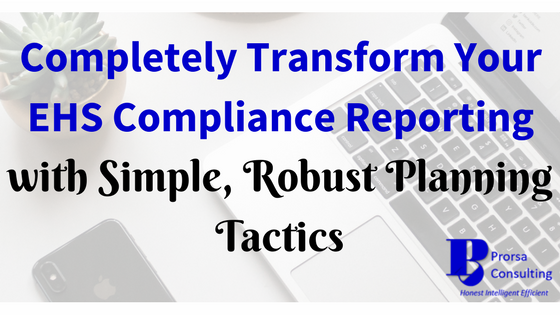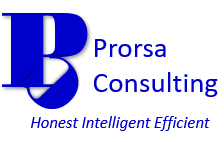Completely Transform Your EHS Compliance Reporting with Simple, Robust Planning Tactics
By : Admin -

I don’t know about you, but time seems to evaporate in my world. EHS professionals tend to wear multiple hats with the expectation of meeting internal and external mandates, including compliance reporting. Often, we are asked to do more with less and must have the right tools to do so. In this post we’ll cover some strategies to keep you on track (and hopefully ahead) with regards to your compliance reporting.
Planning an Overall Strategy
A winning strategy sets you up for success no matter what the objective. In the case of compliance reporting, it is essential to ensure reports are complete, accurate, and timely. Reporting strategies are not one size fits all. As such, each EHS program must tailor a plan of attack, meeting its needs within the constraints of its business resources.
Nevertheless, a good compliance reporting plan starts with some key elements:
- Identification of all required agency reporting & applicable due dates
- Named responsible persons
- Consistent dedication of necessary time to complete compliance reporting
- Tracking
Do You Have a Good Handle on All Your Site’s Required Compliance Reporting and Applicable Deadlines?
My gut tells me the resounding answer to this question from most EHS professionals is “YES!”. But, the permits, regulations, and laws containing our reporting requirements are often long, convoluted, and as understandable as Sanskrit to the untrained eye. If you are relying solely on these documents and your memory to facilitate your submittals, then I would argue your compliance reporting management is not as robust as you may think.
We may not like to admit it, but we are all fallible human beings. Multiple deadlines, stress, personal issues, sickness, and a host of many other things can steal our focus in an instant. So, relying on lengthy documents and our memories to facilitate successful compliance reporting is not the best practice. In addition, managing reporting this way makes it very difficult to apply systematic approaches the effort. How can reporting tasks continue during illness, vacation, termination, etc. when requirements aren’t concisely identified in a manner that is easily accessible by others.
I am and will continue to be a strong advocate for written compliance reporting requirements and deadlines in a tool outside of regulations, laws, permits, and memory. This approach increases transparency, accountability, and the likelihood for sustained compliance. If you have or are planning a formal EHS management system, compliance reporting and applicable deadlines may be integrated into the system’s Legal and Other Requirements. Nevertheless, even those without a formal management system should invest the time to properly identify these items.
Who Is Driving the Bus?
A bus with no driver is out of control. If you are the designated EHS person for your site, then you pretty much know the compliance reporting buck stops with you. But, what if you are working in a team environment where compliance reporting may be completed by a subordinate or colleague? In these situations, reporting can be overlooked without a clear designation of the responsible person.
Identifying a responsible person(s) for compliance reporting in a written format helps to foster ownership and accountability. This only improves the chances your submittals are completed correctly and on time. Also, it facilitates good management practice by having a reference tool to ensure any delegation of duties does not overwhelm any one individual. When dealing with more complex organizational structures, written compliance reporting task assignments are essential to cultivating a systematic approach.
Do You Have Adequate Time to Complete Your Compliance Reporting?
So, you now know the compliance reporting what, when, and who. However, do you often find yourself somehow having to complete 10 hours of work in an hour? If this is the case, you have a time management problem. Specifically, you may not be adequately scheduling your time. Especially with complex reports, scheduling bite sized pieces over time is much more advantageous than waiting until the last minute.
When we don’t appropriately assign the necessary time to complete tasks, deadlines can be missed. Moreover, work completed in a hurried fashion has a higher likelihood of errors and omissions. These can damage your creditability. It is also a pain to have to rework or revise something that you view as already completed.
A strategy to manage compliance reporting task time is integral to success. Especially with complex reports, scheduling bite sized pieces over time is much more advantageous than waiting until the last minute. In addition, delegating or postponing lower priority tasks in the face of an upcoming report may be needed. As with all plans, allowances must be made when the unexpected happens. However, adjustments to an established plan are much easier to make than just winging it and hoping things will get done.
Tracking . . . How Do I Do That?
There are numerous ways to keep track of your compliance reporting efforts. Many of the paid EHS management software platforms have a reporting component integrated into the system to help you. However, if you are running your program on a shoestring budget, the tools below may help strengthen your handle on compliance reporting for free.
The Action Item Matrix (AIM)
This particular format is an oldie but goodie. It allows you to collect all the key elements of your reporting strategy in one place. There are numerous formats for an AIM (you can access an Excel format of one here). The key is to make the matrix detailed enough to ensure all the necessary compliance reporting tasks are captured. Moreover, the AIM needs to be located in a place where it can be easily accessed by all affected persons. With slight modifications, you can even set up your AIM to color code approaching or missed deadlines and calculate on-time submittal rates.
There are some drawbacks to the standalone AIM. It will not give you email or text notifications of approaching deadlines. So, it is paramount that users consult the AIM on a regular basis. Lack of version control is another downside to the AIM. Users must be diligent to ensure they are accessing the most current version of the document at all times. Moreover, multiple users of the document may not be able to access the master file at the same time.
The In-House Compliance Calendar
This solution offers a more automated approach to compliance reporting. It involves inputting tasks into an electronic calendar (individual or shared, depending on needs) like Google or Outlook, which can provide alerts of upcoming deadlines. With information populated in a calendar, responsible persons can easily see compliance reporting tasks in relation to other work and plan more accordingly. Moreover, a shared calendar gives better transparency than relying on individuals to remember to check an AIM.
The downside to in-house compliance calendars is the lack of follow-up tracking. There is no true mechanism to show a task has been completed. Furthermore, electronic calendars seldom allow for more than one notification timeframe to be assigned to an element. These timeframes can be different when multiple individuals are involved because each user sets his/her own settings for notifications.
The Asana Solution
Asana is a web-based service mainly utilized for project management. It can also be used to develop automated compliance reporting calendars. Reporting tasks can be populated into the website with a given due date. Moreover, a responsible individual can be assigned. Other persons can be added to the compliance reporting task to receive notifications. The system then sends reminder emails starting a couple of weeks out from the established task due date.
Once a report is finished and submitted, its compliance reporting task is marked complete in the system. All persons associated with the task have access to the changed status in real time. Moreover, subtasks and attachments can be added to individual tasks. Asana can be synced with other electronic calendars and may be utilized as a free (up to 15 team members) service. Additional team members and features are available through Asana’s paid services.
One of the drawbacks to Asana is the inability to assign more than one responsible person to a task. As with any other web-based service, there is also the possibility of downtime and slow interfaces. You can access more information on Asana at Asana.com.
The Wrap Up
It may be simpler and more cost effective than you think to get control of your EHS compliance reporting. It all starts with identifying the reporting what, when, and who. Implementing a good tracking method pulls these elements together to ensure consistency and accountability. In addition, EHS staff must plan adequate time to ensure successful report completion.
Prorsa Consulting is available to assist you with your EHS compliance, analysis, and management system needs. Check out the Prorsa Consulting Services page and contact us for more information on how we can help you meet your EHS program goals.
Your feedback on this blog’s content is always encouraged. If you found this information useful, be sure to like and/or share below! You can also give your feedback via our Contact Us page.
You can follow Prorsa Consulting on Google+, LinkedIn, Pinterest, and Twitter for regular content updates.
